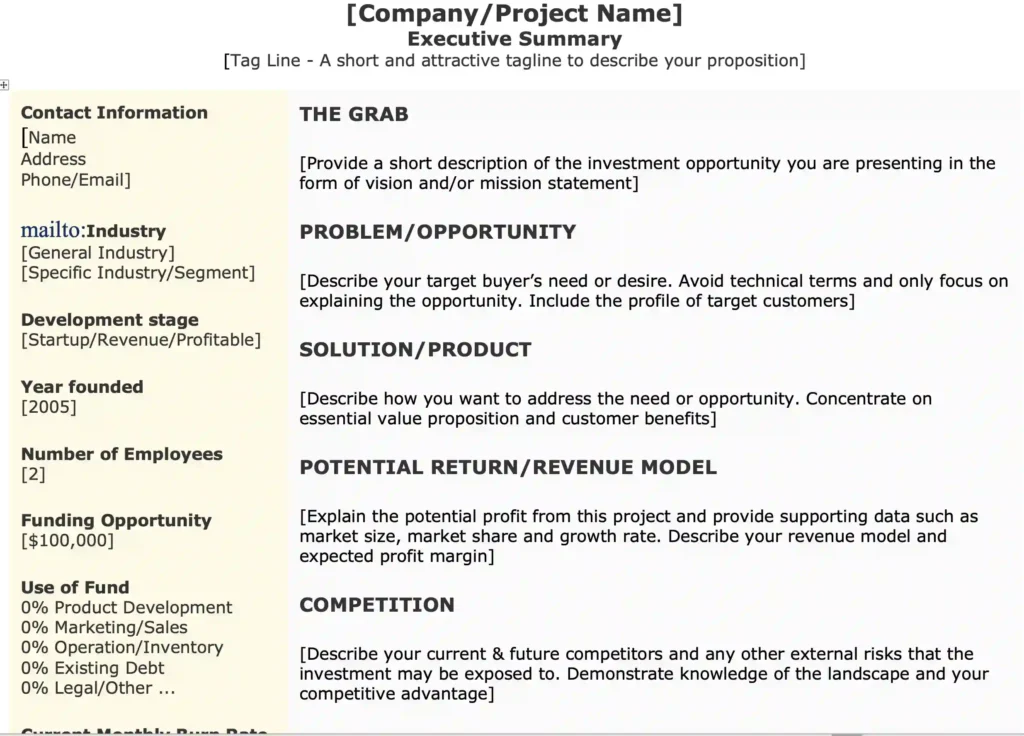
How to Create an Effective Executive Summary Template
How to Create an Effective Executive Summary: A Comprehensive Guide
Introduction
An executive summary is a pivotal part of any business plan or proposal. It provides a succinct overview of your business, highlighting the most critical information in a compelling manner. Since investors and stakeholders often rely on the executive summary to decide whether to engage further, crafting it effectively is crucial. This guide will walk you through the process of creating an impactful executive summary, complete with detailed instructions and practical examples.

Part 1: Crafting the Cover Page and Company Overview
1. Cover Page
• Company/Project Name: Start with the official name of your company or project.
• Example: “EcoWave Technologies LLC”
• Tagline: Create a memorable tagline that encapsulates your business proposition.
• Example: “Harnessing the Power of the Ocean for a Sustainable Future”
• Contact Information: Provide your full name, company address, phone number, and email address.
• Example:
• Name: Alex Martinez
• Address: 789 Ocean Drive, Coastal City, 98765
• Phone: +123 456 7892
• Email: [email protected]
2. Company Overview
• Industry and Development Stage:
• General Industry: Identify the broad category your business falls into.
• Example: “Renewable Energy”
• Specific Industry/Segment: Specify your niche within the general industry.
• Example: “Wave Energy Conversion Technology”
• Development Stage: Indicate the current stage of your business (e.g., Startup, Growth, Established).
• Example: “Startup”
• Year Founded: State the year your company was established.
• Example: “2023”
• Number of Employees: Provide the current number of employees.
• Example: “8”
Part 2: Defining the Funding Opportunity and Financial Snapshot
3. Funding Opportunity
• Funding Required: Clearly state the amount of funding you are seeking.
• Example: ”$750,000”
• Use of Funds: Break down how the funds will be allocated.
• Example:
• 50%: Product Development
• 25%: Marketing and Sales
• 15%: Operations and Inventory
• 10%: Legal and Other Expenses
4. Financial Snapshot
• Monthly Burn Rate: Provide your current total monthly expenses.
• Example: ”$15,000”
• Monthly Revenue: State your current monthly income (if any).
• Example: ”$2,000”
• Existing Debt: Mention any existing debts your company has.
• Example: ”$50,000 in seed loans”
• Existing Investors: Provide details about any current investors, including equity ratios and amounts invested.
• Example: “Angel investor Jane Doe holds a 5% equity stake after investing $100,000.”
Part 3: Highlighting the Opportunity and Addressing the Problem
5. The Grab
• Vision/Mission Statement: Offer a compelling description of your investment opportunity that reflects your company’s vision and mission.
• Example: “At EcoWave Technologies, we aim to revolutionize renewable energy by harnessing ocean waves to provide clean, sustainable power to coastal communities worldwide.”
6. Problem/Opportunity
• Target Buyer’s Need or Desire: Describe the primary need or desire of your target market without technical jargon.
• Example: “Coastal cities face increasing energy demands but lack affordable, sustainable solutions to reduce their carbon footprint.”
• Target Customer Profile: Provide a brief profile of your ideal customers.
• Example: “Our target customers are municipal utility providers in coastal regions seeking renewable energy alternatives to meet environmental regulations and community expectations.”
Part 4: Presenting the Solution and Revenue Model
7. Solution/Product
• Value Proposition and Customer Benefits: Explain how your product or service addresses the identified need.
• Example: “Our wave energy converters offer a consistent and efficient power source, reducing reliance on fossil fuels and lowering energy costs for communities.”
• Customer Benefits: Highlight the key advantages your customers will experience.
• Example: “Customers can expect a 25% reduction in energy costs and a significant decrease in carbon emissions.”
8. Potential Return/Revenue Model
• Profit Potential: Outline the potential profitability, supported by market data.
• Example: “With the global wave energy market projected to reach $10 billion by 2030, capturing even 1% market share could generate annual revenues exceeding $100 million.”
• Revenue Model: Describe how your business will generate income and expected profit margins.
• Example: “Revenue will be generated through the sale and installation of wave energy converters, along with maintenance contracts, aiming for a 30% profit margin.”
Part 5: Analyzing Competition and Outlining the Execution Plan
9. Competition
• Competitors and Risks: Identify current and future competitors, and explain your competitive advantages.
• Example: “Competitors include OceanPower Inc. and WaveTech Solutions. Our competitive edge lies in our patented technology that offers higher efficiency at a lower cost.”
• Risk Factors: Mention any external risks that could impact the investment.
• Example: “Risks involve regulatory changes and technological advancements by competitors that could affect market dynamics.”
10. Execution Plan/Go-to-Market Strategy
• Plan Outline: Summarize your strategies for sales, marketing, development, and partnerships.
• Example: “We plan to initiate pilot projects with select coastal cities, leveraging partnerships with environmental organizations to promote our technology.”
• Milestones:
• Achieved: “Completed successful prototype testing in controlled environments.”
• Planned:
• “Begin commercial deployment in Q1 2024.”
• “Secure contracts with three municipal utilities by Q3 2024.”
Part 6: Detailing Financials and Introducing the Team
11. Financials
• Financial Resources: Describe the financial resources available and those needed for success.
• Example: “Currently operating with $200,000 in seed funding, the additional $750,000 will enable us to finalize product development and expand our operational capabilities.”
• Investment Impact: Explain how the investment will advance your business and plans for future growth.
• Example: “This investment will facilitate our market entry and position us for scaling operations, paving the way for Series A funding in 2025.”
12. The Team/Relevant Experience
• Team Introduction: Introduce key team members and highlight their relevant experience.
• Example:
• Alex Martinez, CEO: “Over 10 years in renewable energy project management.”
• Dr. Emily Chen, CTO: “Ph.D. in Marine Engineering with multiple publications on wave energy.”
• Roles and Responsibilities: Outline specific roles and any additional human resources needed.
• Example:
• Alex Martinez: “Oversees strategic direction and investor relations.”
• Dr. Emily Chen: “Leads technology development and innovation.”
• “Planning to hire a Marketing Director and additional engineers post-funding.”
Conclusion and Final Touches
13. Conclusion
• Recap: Summarize the key points and reinforce why your business is a strong investment opportunity.
• Example: “EcoWave Technologies offers a groundbreaking solution to the growing energy demands of coastal communities, backed by a skilled team and a clear path to market success.”
• Call to Action: End with an invitation for investors to engage further.
• Example: “We invite you to be part of the renewable energy revolution. Contact us at [email protected] or +123 456 7892 to discuss this exciting opportunity.”
Additional Tips for Creating an Effective Executive Summary
1. Keep It Concise: Aim for a summary that’s 1-2 pages, focusing on the most critical information.
2. Use Visuals: Incorporate charts, graphs, or images to enhance understanding and engagement.
3. Tailor It: Customize your executive summary for different audiences, emphasizing what matters most to them.
4. Proofread and Edit: Ensure clarity and professionalism by eliminating errors and improving flow.
5. Gather Feedback: Seek input from mentors or advisors to refine your summary.
If you are looking to download a professionally made template with detailed documentation, please click to the link below


